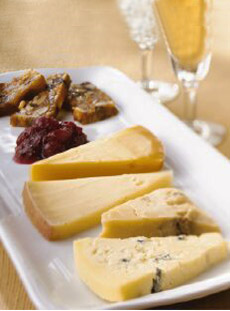

How would you describe these cheeses? See the cheese descriptors below. Photo courtesy Wisconsin Milk Marketing Board.
February 2010
|
 |
Tasting Cheese 101 ~ What’s The Word?
Page 2: How To Describe Cheese
If you’ve ever struggled for words to describe cheese—here they are. If your prior vocabulary was limited to mild, tangy, and sharp, you’re about to discover the many ways in which industry professionals and connoisseurs describe a piece of cheese. If the aromas and flavors of cheese begin to resemble those you’ve used or heard used to describe wines, you’re beginning to understand a common language of food (and also why wine and cheese pair so well). This is Page 2 of a five-page article. Click on the black links below to visit other pages.
Need A Word (Or Three) To Describe Your Cheese?
Here are descriptive terms for cheese. Different cheeses have specific characteristics. For example:
- A fresh goat cheese can be milk white, floral or herbaceous, moist and soft.
- A Roquefort can be ivory, sweet, salty, pungent, mildly acidic, complex, creamy and crumbly.
- A Brie can be ivory, buttery, mushroomy, elastic and melting.
- An aged Cheddar is deep yellow, crumbly, moist, sharp and peppery.
| |
Positive Characteristics/Descriptors |
Defects |
Color |
hay, pale hay, rich hay; white, milk white, chalky white, ivory; yellow, yellow gold, deep yellow, orange
|
bicolore, bleached (for rindless cheeeses) brown, dull, faded, mottled |
Aroma & Flavor |
acid(1), barnyardy, bold, buttery, clean, earthy, flat, floral, fragrant, fruity (and particular fruits, e.g. blackberry in Robuchon and plum in Comté), gamey, goaty, hay, herbaceous, intense, mild, mushroomy, nutty, pasture, peppery, persistent, pungent, milky, salty, satiny, sharp, sheepy, silky, straw, sweet, tart, typical, well balanced
|
Aroma: ammoniated(2), sour, spoiled
Flavor: astringent(3), bitter(4), biting, chemical(5), fermented, flat, mealy, metallic, oversalty, pungent, putrid, rancid, , soapy, sour, sulfurous, unbalanced, weak
|
Touch |
coarse, compact, crumbly, elastic, fibrous, firm, flaky, grainy(6), hard, moist, rubbery, soft, smooth, sticky
|
mealy, oily, pasty, waxy |
Palate |
buttery, chewy, creamy, finely granular, melting, soft, sticky
|
chalky, grainy, gummy, sandy |
(1) A pleasant tang and sourish flavor due to a concentration of acid.
(2) Ammoniated or ammoniacal designates the heavy smell or taste of ammonia as a result of being overripe or mishandled (i.e., held at fluctuating temperatures). This condition can afflict bloomy rinds, such as Brie, Camembert and some chèvres. A hint of ammonia is not objectionable, but heavy ammoniation is.
(3) A harsh taste with a puckery, almost medicinal quality.
(4) An unpleasant, biting flavor, usually a bitter aftertaste, sometimes associated with variations in manufacturing and curing or aging procedures in high-moisture content cheese.
(5) An aroma or flavor taint which usually indicates improper manufacturing or contamination with foreign materials.
(6) Grainy is a characteristic of grating cheeses; it’s desirable in those cheeses and a flaw in others.
Continue To Cheese Glossary
Go To The Article Index At The Top Of The Page
Lifestyle Direct, Inc. All rights reserved. Images are the copyright of their respective owners.

|


